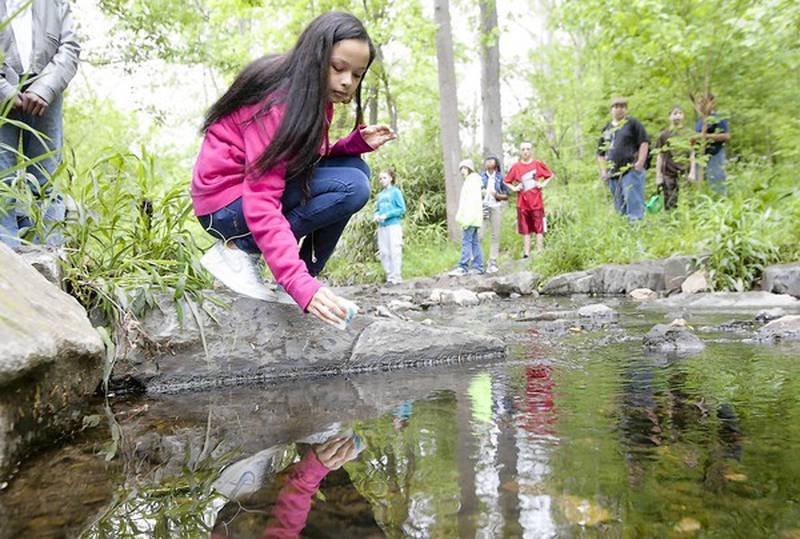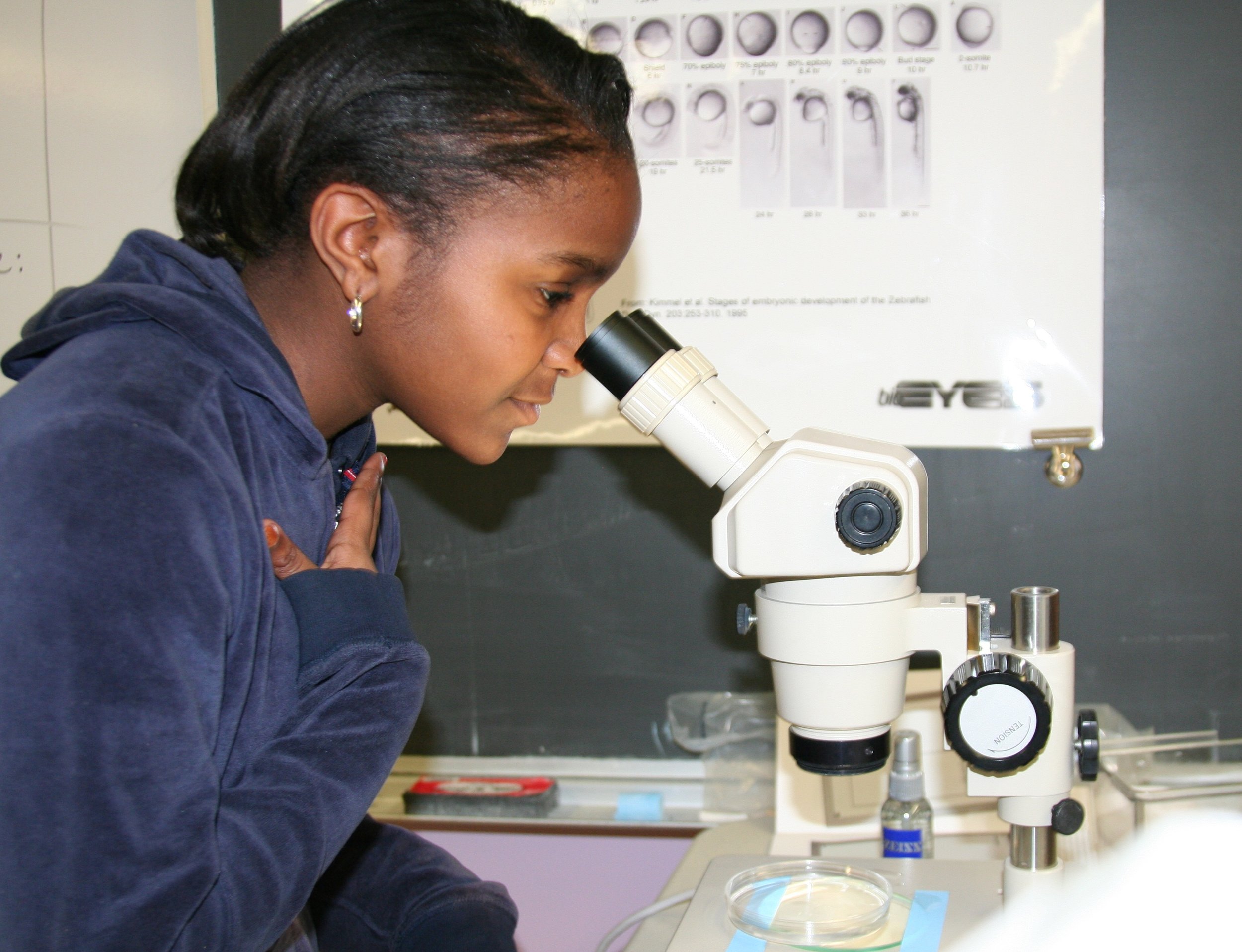BioEYES In the News
AUDIO | AWARDS | PRESS | STAFF PUBLICATIONS | STAFF RESEARCH | VIDEOS
"Focusing young eyes on biology"
Jenn Smith, North Adams Transcript via the Internet Archive Wayback Machine
"On Friday, the fourth-graders put their developing fish -- some creatures given names like 'Squishy,' 'Squirmy' and 'Nemo' -- under microscopes brought in by the college. Since zebrafish embryos are transparent, the students were able to observe organs, a heartbeat and blood flow in their specimens. Audible reactions from the kids ranged from 'whoa,' to 'eww' to 'weird.' 'I thought it was really fun to have fish in our school because we don’t get live animals here very often,' said fourth-grader Connor Cirullo."
"Making a Difference: Education at the 10th International Conference on Zebrafish Development and Genetics"
Lara D. Hutson, Jennifer O. Liang, Michael A. Pickart, Chris Pierret, and Henry G. Tomasciewicz; Zebrafish, Special Issue: Zebrafish in Education
The guest editors of this special issue of Zebrafish included BioEYES co-founder Dr. Jamie Shuda.
"When researchers converged on Madison this year at the 10th International Conference on Zebrafish Development and Genetics, a number of them, along with a contingent of teachers, administrators, and students, met over the course of two sessions of the 'Zebrafish in Education' Workshop. The zebrafish system has great potential to impact learning in a wide range of fields, including, but not limited to, developmental biology, genetics, evolutionary biology, toxicology, environmental science, disease mechanisms, drug development, and genetic engineering. Many groups throughout the world have begun using zebrafish in a wide variety of ways to facilitate K–12 and undergraduate learning."
“BioEYES Awarded Viktor Hamburger Outstanding Educator Prize”
Marsha E. Lucas, The Society for Developmental Biology
“The partnership of a scientist and an educator made BioEYES a success. Shuda was able to take Farber’s many great ideas, and then hone in on those that were actually doable for a classroom of 30 students. She studied the educational standards for different age groups and designed the BioEYES program around them. In an interview prior to the SDB meeting she said her focus was ‘how can we take something that’s already suppose to be taught, but do it in a way that’s very student centered, that actually gets them to explore science, and allows the teachers to actually have fun teaching these concepts.’ The program gets students to think like a scientist while at the same time reinforces basic reading, writing, and math skills.”
BioEYES' environmental program, "Your Watershed, Your Backyard"
Towson University
Your Watershed, Your Backyard is made possible through the generous support of the Chesapeake Bay Trust and General Motors. Produced in HD by Jennifer Bond & Andrew Stephens at Towson University Electronic Media & Film Department in the Spring of 2012.
"Hampden Students Release Tiny Trout into Stony Run"
Larry Perl, Baltimore Sun
"'Our fish will be leaving the building,' came the announcement over the public address system at Hampden Elementary/Middle School on May 3. Minutes later, 15 seventh-graders would rush 204 trout tykes in an ice cooler full of water to Roland Park to be released into the Stony Run. The student body had one last opportunity to visit the tiny rainbow trout that were grown from hatched eggs in the school's science lab starting early this year."
BioEYES at Stanley Clark School
2nd grade students, Stanley Clark School, South Bend, IN
This is a student directed video by 2nd grade students from Stanley Clark School in South Bend, IN. They are describing their week of BioEYES- a week long hands on activity studying adult zebrafish and their offspring. The students did an EXCELLENT job! Their teachers, Mrs. Michelle Havens, and Marianne King did a wonderful job too!
"Carnegie's BioEYES Honored Twofold"
Carnegie Institution for Science
"Carnegie’s educational outreach program, BioEYES, will be the recipient of the 2012 Viktor Hamburger Outstanding Educator Prize from the Society for Developmental Biology. BioEYES founders Steve Farber and Jamie Shuda (University of Pennsylvania), will accept the award at the upcoming annual meeting of the society in Montreal in July."
Project BioEYES at Garrett Heights EMS
Baltimore City Public School System Channel 77
In December of 2011, Channel 77 for the Baltimore City Public School System filmed this video showing Project BioEYES being presented to a group of fifth grade students at Garrett Heights Elementary-Middle School. The program was presented by BioEYES Baltimore Program Manager Valerie Butler from the Carnegie Institution for Science Department of Embryology.
"Carnegie's BioEYES Hosts Watershed Fieldtrip”
Carnegie Institution for Science
"Carnegie’s educational outreach program, BioEYES, has joined forces with General Motors (GM), and Earth Force to take Walter P. Carter Elementary/Middle School students on a knee-deep watershed lesson on December 1, 2011. The group will monitor water quality, sample aquatic insects (indicators of stream health), go on a nature walk, and identify water problems in the Herring Run watershed near the school to teach students about science, the environment, and much more."
"Schooling Fish: BioEYES aims to get students excited about science"
Andrea Appleton, Baltimore City Paper
"On a recent Friday morning, a class of fifth-graders at Coldstream Park Elementary were not so much attentive as enthralled. Some students oohed and aaahed over a microscope where an anesthetized zebrafish larva lay, its heart visibly beating through its transparent body. Others hunkered over petri dishes, murmuring and pointing."
"Promoting Science Through Project BioEYES"
Nora Zietz, Baltimore's Child via the Internet Archive Wayback Machine
"If your child attends one of about 38 public schools or a handful of lucky private schools in the Baltimore area, there is a good chance he or she can tell you why it makes evolutionary sense for a female zebrafish to lay 200 to 600 eggs a week. In fact, your youngster may have already told you more about the zebrafish and its genetic code, stem cell biology, and the impact of the environment on living organisms than you can remember from your own school days."
"BioEYES: Inspiring Youth to Pursue Science"
Valerie Butler, The Node
"Most of us, I’m sure, can remember that AHA moment in school when we realized that science is pretty cool. Imagine how it might be for a student enrolled in a school lacking the resources to teach science well, or who was never given the opportunity to excel in anything, let alone science. What if the opportunity for an AHA moment never arrived? This is, unfortunately, the truth for many primary and secondary school students, and it is especially so for low-income and predominantly minority communities. Students from disadvantaged backgrounds often carry stereotypes that scientists are old, white men who are out of touch with society, and many youth believe that science careers are out of their reach. the challenge then, is how to excite children about science such that they want to make a career of it?”
BioEYES in Australia
Monash University
BioEYES co-founder Dr. Jamie Shuda traveled to Melbourne, Australia to help Monash University and the Australian Regenerative Medicine Institute set up a local BioEYES program.
"Educational Pioneer BioEYES Goes Down Under"
Carnegie Institution for Science
“The innovative, educational, outreach program BioEYES has now been adopted by Monash University and the Australian Regenerative Medicine Institute. The down-under partnership program debuts this August. BioEYES is designed to foster an interest in and a love for science in elementary, middle, and high school students. Over the course of one week, students watch the transparent zebrafish, Danio rerio, grow from a single-celled zygote to a larval fish complete with a beating heart. Since its inception in 2002, BioEYES has served nearly 35,000 students in Philadelphia, Baltimore, and South Bend, Indiana. The Australian partnership is the program’s first foray abroad.”
"Students Participate in National Science Program" (PDF)
The Hearing and Speech Agency
"'The BioEYES project was over last Friday and today [Thursday] the children are still talking about it,' says Jill Berie, Educational Director at Gateway School. 'The project was perfect for our students,' she continued. 'Every child had a job, so every child had a chance to do real science and that is an idea we can continue to build upon.'"
"Turning Students on to Science" (PDF)
Elizabeth Finkel, Cosmos Magazine (Australia)
"How then to impart the awe and wonder of science back to jaded students? Enter BioEYES. BioEYES is a science activity based on the development of the zebrafish - a creature that has been causing lots of awe and wonder since it made its debut in labs a decade or so ago. Seeing these little striped fish swimming around the tank, it might not be too obvious why. It's when you see their eggs that the awe hits you. They are transparent: all the wondrous events that transform a yolky one-cell egg into a swimming fish take place right in front of your eyes."
BioEYES in Baltimore County Public Schools
BCPS News
This video spotlights the science outreach program, BioEYES, in Baltimore County Public Schools. It also contains footage of scientist and founder of BioEYES, Dr. Steven Farber, and an inside look at the Carnegie Institution for Science, home to BioEYES Baltimore.
"Outreach: Empowering Students and Teachers to Fish Outside the Box" (PDF file)
Jamie Shuda and Danielle Kearns-Sixsmith, Zebrafish
"For most students and teachers exposed to Project BioEYES curriculum, this series of laboratory activities offers both measurable and immeasurable reactions. For students, the experience has provided a 'glimpse into their own bodies and a more meaningful understanding of organ systems, often generating a strong visceral reaction, unlikely to be duplicated by a video or picture'...."
"A Conversation With Steven A. Farber: To Teach Genetics, Zebra Fish Go to School"
Claudia Dreifus, The New York Times
"Kids like animals. The fish grab their interest. The teachers tell me that they don’t have attendance problems in the week we’re there. Most of the children we see are low-income.... Some of what we see is heartbreaking. We got a letter from a Philadelphia youngster named Dasha. She wrote us something like: 'I just wanted to thank you for coming to our class. I think you thought we were the worst class you ever had. All our teachers say that. Thank you for letting us use your microscope.' Can you imagine kids hearing that from teachers?"
"Making Outreach Work: How a Take-Your-Child-to-Work Day Helped Launch a $200,000 Education Initiative"
Steven Farber, The Scientist
"High school students, TJU minority groups, and inner city summer science programs all made their way through our cramped, noisy, humid space to see several thousands of our research subjects. The tour would culminate with a view through the microscope at the larval beating heart. I later learned, mostly through letters from the departments sponsoring these tours, that the visit to my laboratory was often the highlight of the day. I also learned, as is often the case in a large institution, that if you do something well you usually get asked to do it again. As I became more involved, however, I realized that I could not sustain this kind of effort alone. This was, in part, my motivation for starting Project BioEYES."















